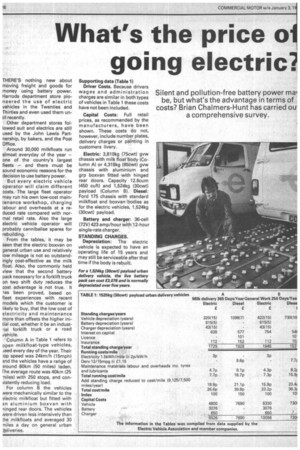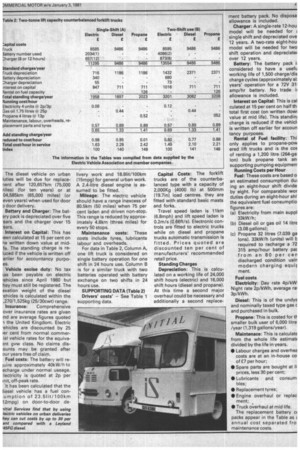What's the price ol goi ng electric.
Page 28

Page 29

If you've noticed an error in this article please click here to report it so we can fix it.
Silent and pollution-free battery power ma‘ be, but what's the advantage in terms of costs? Brian Chalmers-Hunt has carried oua comprehensive survey.
THERE'S nothing new about moving freight and goods for money using battery power. Harrods department store pioneered the use of electric vehicles in the Twenties and Thirties and even used them until recently.
Other department stores followed suit and electrics are still used by the John Lewis Partnership, by bakers, and the Post Office.
Around 30,000 milkfloats run almost everyday of the year — one of the country's largest fleets — and there must be sound economic reasons for the decision to use battery power.
But every electric vehicle operator will claim different costs. The large fleet operator may run his own low-cost maintenance workshop, charging labour and overheads at a reduced rate compared with normal retail rate. Also the large electric vehicle operator will probably cannibalise spares for rebuilding.
From the tables, it may be seen that the electric boxvan on general urban use and relatively low mileage is not so outstandingly cost-effective as the milk Float. Also, the commonly held view that the second battery pack necessary for a forklift truck on two shift duty reduces the cost advantage is not true. It las been proved, based on fleet experiences with recent models which the customer is likely to buy, that the low cost of electricity and maintenance more than offsets the higher initial cost, whether it be an indust'lel forklift truck or a road vehicle.
Column A in Table 1 refers to open milkfloat-type vehicles, used every day of the year. Their :op speed was 24km/h (15mph) end the vehicles have a range of around 80km (50 miles) laden. rhe average route was 40kin (25 miles) with 250 stops, and consistently reducing load.
For column B the vehicles Nere mechanically similar to the electric milkfloat but fitted with 3 n aluminium boxvan with iinged rear doors, The vehicles Nere driven less intensively than :he milkfloats and averaged 30 miles a day on general urban deliveries. The diesel vehicle on urban luties will be due for replacelent after 120,657km (75,000 niles) (for ten years) or at 04,585km (65,000 miles) (or even years) when used for door D door delivery.
Battery and Charger: The batary pack is depreciated over five :ears and the charger over 15 Interest on Capital: This has leen calculated at 15 per cent on le written down value at midfe. The standing charge is reluced if the vehicle is written off arlier for accountancy purpoes.
Vehicle excise duty: No tax las been payable on electric tehicles since April 1980 but hey must still be registered. The axation weight of the diesel :ehicles is calculated within the ,270/1,525kg (25/30cwt) range.
Insurance: Comprehensive over insurance rates are given nd are average figures quoted the United Kingdom. Electric :ehicles are discounted by 25 ler cent from normal commerial vehicle rates for the equiva3nt gvw class. No claims disounts may be granted after our years free of claim.
Fuel costs: The battery will relure approximately 40kW/h to echarge under normal useage. .lectricity is quoted at 2p per in it, off-peak rate.
It has been calculated that the liesel vehicle has a fuel conumption of 23.5Iit/1 00krn 12mpg) on door-to-door de
7itial Services find that by using lectric vehicles on urban deliveries hey can cut costs by up to 30 per ant compared with a Leyland 45FG
livery work and 18.81it/100km (15mpg) for general urban work. A 2.4-litre diesel engine is assumed to be fitted.
Mileage: The electric vehicle should have a range inexcess of 80.5km (50 miles) when 75 per cent laden and driven non-stop. This range is reduced by approximately 4.8km (three miles) for every 50 stops.
Maintenance costs: These costs include tyres, lubricants labour and overheads.
For data in Table 2, Column A, one lift truck is considered on single battery operation for one shift in 24 hours use. Column 13 is for a similar truck with two batteries operated with battery exchange on two shifts in 24 hours use.
SUPPORTING DATA (Table 2) Drivers' costs' See Table 1 supporting data. Capital Costs: The forklift trucks are of the counterbalanced type with a capacity of 2,000Kg (4000 lb) at 500mm (19.7in) load centres. they are fitted with standard basic masts and forks.
Travel speed laden is 11km (6.8mph) and lift speed laden is 0.2m/s (0.66ft/s). Electronic controls are fitted to electric trucks while on diesel and propane trucks automatic transmission is fitted. Prices quoted are discounted ten per cent of manufacturers' recommended retail price.
Standing Charges Depreciation: This is calculated on a working life of 24,000 shift hours (electric) and 16,000 shift hours (diesel and propane). At this time a second major overhaul could be necessary and additionally a second replace ment battery pack. No disposa allowance is included.
Charger: A single-rate 12-hou model will be needed for ( single shift and depreciated ove 12 years. A two-rate eight-hou model will be needed for two shift operation and depreciate( over 12 years.
Battery: The battery pack i: considered to have a usefu working life of 1,500 charge/dis charge cycles (approximately Si: years' operation for a 72V 31! amp/hr battery. No trade ii allowance is included.
Interest on Capital: This is cal culated at 15 per cent on half th, total first cost (on written dowi value at mid life). This standini charge is reduced if the vehicli is written off earlier for accoun tancy purposes.
Rental of Fuel facility: Thi only applies to propane-pow ered lift trucks and is the cos of renting a 1,200 litre (264-ga Ion) bulk propane tank an supporting pumping equipment Running Costs per Hour Fuel: These costs are based o an estimated consumption dui ing an eight-hour shift divide by eight. For comparable wor duties during an eight-hour shi the equivalent fuel consumptio figures are: (a) Electricity from main suppl 33kW/h; (b) Diesel oil or gas oil 14 litre (3.08 gallons); (c) Propane 32 litres (7.039 ga Ions). 33kW/h (units) will b required to recharge a 72 315 amp/hour battery par from an 80 per cen discharged condition usin modern charging equir ment.
Fuel costs Electricity: Day rate 4p/kWI Night rate 2p/kWh, average rat 3p/kWh.
Diesel: This is of the undye and nominally taxed type gas c and purchased in bulk.
Propane: This is costed for tlsmaller bulk user of 6,000 litre /year (1,319 gallons/year).
Maintenace: This is calculate from the whole life estimatE divided by the life in years.
• Labour charges and overhea costs are at an in-house co of £7 per hour; • Spare parts are bought at Ii prices, less 30 per cent; • Lubricants and consum hies; • Replacement tyres; I Engine overhaul or replac ment;
• Truck overhaul at mid life.
The replacement battery c( packs appear in the Table as E: annual cost separated fro maintenance costs.












































































